PRINCETON, NJ -- In the aftermath of the Sandy Hook Elementary School shooting in Newtown, Conn., ÆéûÜǨû§finds 58% of Americans in favor of strengthening the laws covering the sale of firearms, up from 43% in 2011. Current support for stricter gun laws is the highest ÆéûÜǨû§has measured since January 2004, but still not nearly as high as it was in the 1990s.
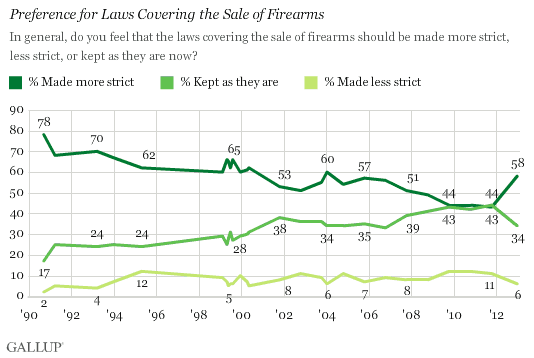
These results are from a USA Today/ÆéûÜǨû§poll conducted Dec. 19-22, just days after the Newtown tragedy. Gallup's prior measure of Americans' attitudes toward new gun laws was conducted in October 2011. Since then, there have been several other mass shootings in the U.S., including one in July at a Colorado movie theater that left 12 dead and more than 50 wounded. More recently, a gunman killed his boss and four others at a factory in Minneapolis in September, and in August a U.S. Army veteran opened fire in a Sikh temple in Wisconsin, killing six.
Perhaps as a result of these events, the new poll also finds that a record-high 47% of Americans favor passing new gun laws, up from 35% in 2011. Since ÆéûÜǨû§first asked this question in 2000, majorities have consistently preferred enforcing the current laws more strictly without passing new laws.
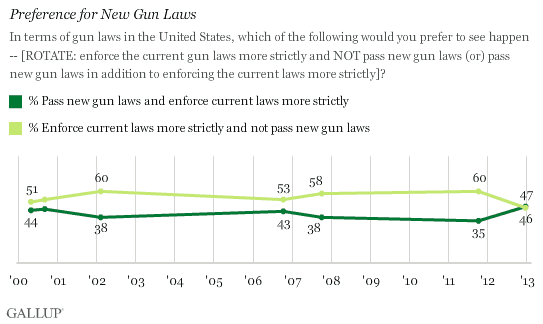
Opponents of Assault Rifle Ban Still Outnumber Proponents
Two aspects of the Newtown shooting that have been a focal point of recent discussions about gun laws are the semi-automatic rifle and high-capacity ammunition magazines used by the shooter. Several state and federal lawmakers have already announced that they will seek to ban both from the commercial market.
Nevertheless, Americans' views on the sale of assault rifles are unchanged. The slight majority, 51%, remain opposed to making it illegal to manufacture, sell, or possess semi-automatic guns known as assault rifles.
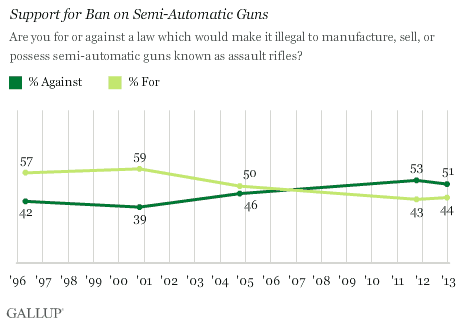
Notably, the 44% in favor of assault rifle bans in response to this trend question is nearly identical to the 42% ÆéûÜǨû§found in a Dec. 18 poll. In that survey, participants responded to a question asking about possible approaches to preventing mass shootings at schools, similar to the shooting that occurred Dec. 14 in Connecticut.
Americans Favor Limits on Gun Show Sales and High-Capacity Magazines
A significantly higher percentage of Americans -- 62% -- do favor banning the sale of high-capacity ammunition magazines, generally defined as those that contain more than 10 rounds. Also, nearly all Americans -- now 92%, up from 83% in 1999 -- favor laws that require people attempting to purchase guns at gun shows, including gun dealers, to undergo background checks.
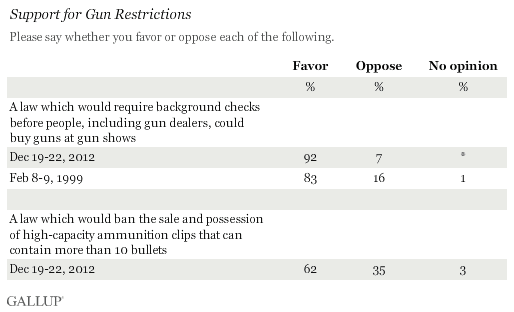
Opposition to Handgun Ban Hits Record-High 74%
Despite Americans' willingness to strengthen gun laws in the wake of Sandy Hook and other deadly mass shootings, ÆéûÜǨû§finds public opposition to a broad ban on the possession of handguns at a record-high 74%. Conversely, the 24% in favor is the lowest recorded since ÆéûÜǨû§first asked the question in 1959.
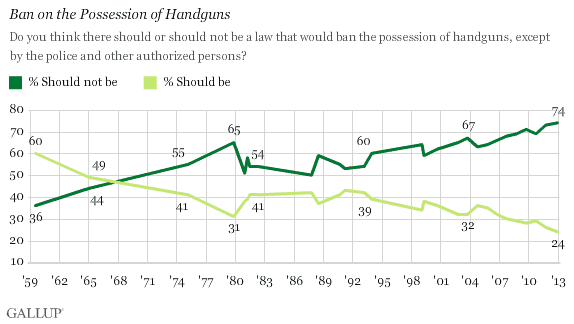
Bottom Line
Americans favor new legislation to limit gun sales, presumably to help prevent the kind of gun violence that became all too familiar in 2012. This is seen in increased support for making the laws covering the sale of firearms more strict, and for passing new gun laws. However, views toward banning semi-automatic guns or assault rifles are unchanged, and -- possibly reflecting Americans' desire to defend themselves given the rash of high-profile gun violence -- a record-high 74% oppose preventing anyone but the police or other authorized officials from owning a handgun.
Survey Methods
Results for this USA Today/ÆéûÜǨû§poll are based on telephone interviews conducted Dec. 19-22, 2012, with a random sample of 1,038 adults, aged 18 and older, living in all 50 U.S. states and the District of Columbia.
For results based on the total sample of national adults, one can say with 95% confidence that the maximum margin of sampling error is ôÝ4 percentage points.
Interviews are conducted with respondents on landline telephones and cellular phones, with interviews conducted in Spanish for respondents who are primarily Spanish-speaking. Each sample includes a minimum quota of 400 cellphone respondents and 600 landline respondents per 1,000 national adults, with additional minimum quotas among landline respondents by region. Landline telephone numbers are chosen at random among listed telephone numbers. Cellphone numbers are selected using random-digit-dial methods. Landline respondents are chosen at random within each household on the basis of which member had the most recent birthday.
Samples are weighted by gender, age, race, Hispanic ethnicity, education, region, adults in the household, population density, and phone status (cellphone only/landline only/both, cellphone mostly, and having an unlisted landline number). Demographic weighting targets are based on the March 2011 Current Population Survey figures for the aged 18 and older U.S. population. All reported margins of sampling error include the computed design effects for weighting.
In addition to sampling error, question wording and practical difficulties in conducting surveys can introduce error or bias into the findings of public opinion polls.
View methodology, full question results, and trend data.
For more details on Gallup's polling methodology, visit .
